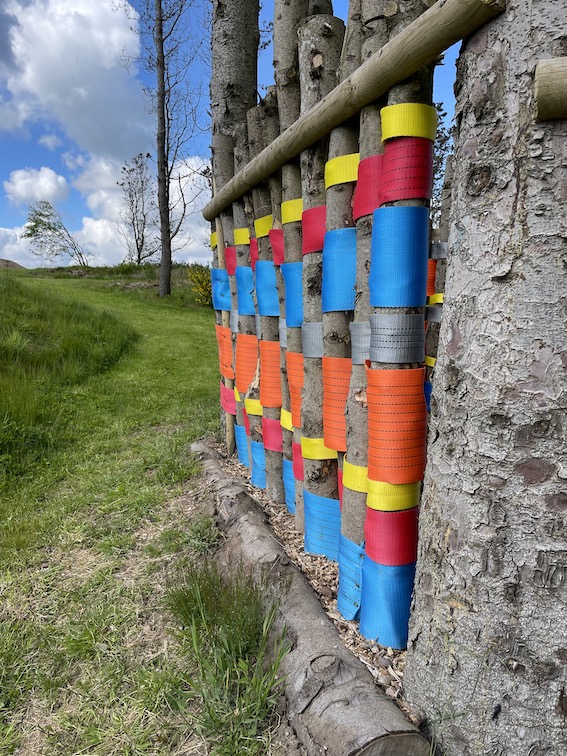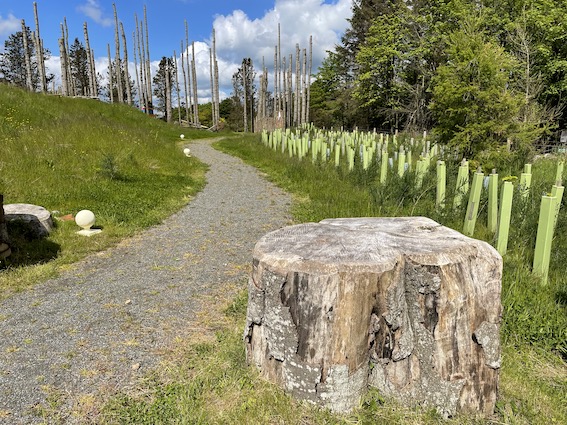Early this year, a natural playground opened in Aberdeenshire that has been named after one of Scotland’s most enigmatic climbers of the twentieth century, Tom Patey. He was born in Aberdeenshire, trained in medicine at Aberdeen University and finally ended up as a GP in Ullapool. From his university days onwards, he was a prolific rock and ice climber, setting up new routes across Scotland, many of them now recognised as classic climbs.

Sadly Tom Patey died in a climbing accident in 1970, aged 38. He had just finished writing his only book, One Man’s Mountains. He became famous – a household name – on account of a BBC documentary covering the live climb of the Old Man of Hoy. He was one of the principle organisers of this epic event and a key climber. If you care to look at this video, then it’s well worth also looking at the shorter video of Catherine Destivelle soloing the same sea stack in 1998. It gives a good comparison about how climbing has developed over a 20+ year period.

When I heard the name of this playground, my curiosity was piqued. What features would be offered that recognise the climbing heritage of Scotland? Sadly, at present, I discovered the playground, whilst interesting, really doesn’t feature climbing in any form. The nearest acknowledgement of a climbing link is the use of webbing to create a den-like structure in one part of the grounds.

However, saying this, my understanding is that in due course, as the playground is used and evolves with children playing there, other features may be added, so perhaps this will change. A good example of climbing features within a natural playground can be seen in the Morialta ‘Mukanthi’ blog post which featured climbing rocks to suit a range of ages and abilities.

The presence of dens and social spaces are key aspects to this natural playground. They have been sensitively created to avoid one dominating the place and there’s enough for different groups of children.

If you look at each of the social spaces, they are very different both in feel and the use of the materials in construction. The webbing area has a muddy surface and quite open in feel. The space above is clearly defined and bark chipped.

Above the gathering spot is in a quieter place – you have to look to find it as it’s enclosed by trees and a grassy bank.

Above you can see this is a grit pit, but it also supports a group to play here. The presence of grass growing through, suggests, this is being missed along side a lack of play traces. Saying that, the playspace is new, and sited away from the main thrust of the town. In due course more houses will be built closer to the playground. This will impact on use.

Another defining feature is the pathways through and around the site. These are a mix of buggy/wheelchair accessible grit surfaces as seen above and mown pathways, and those placed on the wee hillocks – see below.

Again, as the site settles down and becomes subject to greater wear and tear, it will be interesting to see how children playing there shape the pathways: which new ones emerge and which ones are simply not part of how children use the space.

Some features invite exploration such as the giant steps. The size and scale of these are great. There is a similar set in another part of the park which is mildly disappointing – I like variety and choice so would have looked for an alternative set climbing steps. If you look at the Cramond School blog post, you will see the diversity of features on the slope around the playground which enable a range of choices. Often, however, this sort of decision is simply a lack of budget rather than imagination on the part of the designers.

Throughout the playground there are many natural loose parts left in situ from recent high winds and rocks that are part of the landscape. This is always a nice touch, and many have imaginative appeal.

And the natural balance beams definitely have a crocodile persona..

One feature I thought was novel and interesting was the log stack root system. Although the signs stipulate this is a playground for children 8yrs and over, there is no doubt that such features have toddler appeal.

All-in-all, it was great to be able to visit this playground and that the community have invested in a natural playscape is brilliant as part of making the new town child-friendly. The use of natural features has been wonderful and it’s clear good use has been made of what’s already in place: locally available materials.

There were also flags that could be hoisted around the park, with children’s work featured…

One key focal point was the swings. Fantastic to see amidst the natural features as children often like a combination of traditional playground equipment and natural spaces.

Finally, I couldn’t find any reference to who has designed this space, which is a pity as I alway think a little acknowledgement goes a long way. My gut feeling is that this is the work of Judi Legg and Sue Gutteridge or a designer who has been influenced by their work. I’ve blogged previously about Judi and Sue’s work here.




















Your wonderful article above was forwarded to us through friends and I thought I would give a bit of background. The playpark was delivered ahead of schedule because our growing community at Chapelton needed somewhere for the young to hang out. We were disappointed with the formal play areas that are usually on offer and have long wanted to to offer an area with a bit more of a challenge. The digger work was carried out by our farm manager, David Finlay, in lockdown. He was on his own and able to get on with enhancing the existing topography.
Then my husband and I, together with our amazing landscape consultants for the whole scheme, Benton Scott Simmons, and our landscaping contractors set about trying to make the most of the area based on group play and some of the storm blow. We are all from an older generation who loved building dens and mucking around and getting dirty so wanted to offer something that harked back. We are going to add to the equipment responding to what the residents would like to see and we have some ideas for making a wet slide from time to time on the grassy slope using a water bowser and baler wrap from the farm.
We were as disappointed as you that the climbing activities had to be scaled back after a RoSPA inspection! In fact it has taken two years to bring into use thanks to badgers, storms and planning permission.
Hello Caroline
Thanks for such a detailed comment that is so helpful in terms of background information. David Finlay did an excellent landscaping job and I think the use of storm blown trees has been encouraging to see. I do hope that your vision for the further developments are realised in due course – and that the children of Chapelton love and value this site.
Google brought me here as Tom Patey was my great uncle. It’s fascinating to see that this park was opened this year in his name. What a wonderful tribute. I’d love to know how it was decided, and by who, that the park should be named after him. Thank you for writing this article.
Thank you for taking the time to comment. I’m not entirely sure who made the decision about the park’s name but I agree it’s a lovely tribute to your great uncle and so important that his legacy is recognised beyond the world of rock and ice climbing.
Sorry, correction, he wasn’t my great uncle he was my grandfathers cousin.
So glad you are happy Will. It was my husband who has named all the streets and buildings at Chapelton. We wanted to name the park after a climber because the topography is challenging and we wanted to inspire the youngsters to explore and achieve as much as they could. When we contacted the Scottish climbing organisation they recommended your grandfathers cousin. We could not be happier with the choice.